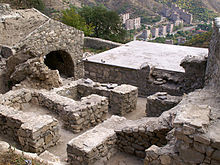| Battle of Halidzor | |||||||||
|---|---|---|---|---|---|---|---|---|---|
| Part of the Syunik rebellion | |||||||||
 | |||||||||
| |||||||||
| Belligerents | |||||||||
| Armenians of Syunik |
| ||||||||
| Commanders and leaders | |||||||||
|
David Bek Mkhitar Sparapet Ter Avetis | Unknown | ||||||||
| Strength | |||||||||
| 300 |
| ||||||||
| Casualties and losses | |||||||||
| Light | 13,000 | ||||||||
The Battle of Halidzor (Armenian: Հալիձորի ճակատամարտ) took place in the spring of 1727 at Halidzor Fortress, in what is now the Syunik region of Armenia, near the modern-day city of Kapan, between the Armenian forces under the leadership of David Bek and the Ottoman army.
Battle
The main account of the Battle of Halidzor comes from the mid-eighteenth-century Armenian work Patmutiun Ghapantsvots (Armenian: Պատմութիւն Ղափանցւոց) by Ghukas Sebastatsi. The battle took place amidst a larger military campaign launched by the Ottoman Empire in the 1720s to secure control over the South Caucasus. The Ottomans encountered fierce resistance by local Armenian princes and lords in Syunik, especially near the town of Kapan, with David Bek, Mkhitar Sparapet and Ter Avetis at the head of small make-shift forces.
In the spring of 1727, pursued by the Ottomans, David Bek and his followers took refuge in the fortress at Halidzor. The Ottoman army put Halidzor under siege but came under incessant attacks launched by small Armenian units from the fortress. David Bek's comrades-in-arms, Mkhitar and Ter Avetis did their best to boost the morale of the men in the fortress, proclaiming, "Take heart, do not be afraid, follow us, and if our end has arrived, let us die bravely, because for us it is better to die with courage outside the walls than to see before our eyes the death of our families and friends inside the walls."
After seven days, the Ottomans abandoned their emplacements and retreated. According to Armenian sources the remnants of the army dispersed across the region, with confusion and panic raging among its ranks.
While the author of Patmutiun Ghapantsvots exaggerates the size of the Ottoman army and the small size of the Armenian force, the difference between the two sides must have been significantly in favor of the Ottoman attackers. The victory at Halidzor greatly encouraged the Armenian rebels, who then expelled Ottoman forces from the area around Kapan and subsequently advanced south toward Meghri.
Cultural impact
The battle is depicted in the 1978 Soviet Armenian film about Davit Bek's rebellion, Star of Hope.
See also
References
- ^ Mikayel Chamchian, History of Armenia, in The Heritage of Armenian Literature, Volume III: From the Eighteenth Century to Modern Times, eds. Agop Jack Hacikyan et al. (Detroit: Wayne State University Press, 2005), pp. 176–179.
- Aivazian, Armen M. (1997). The Armenian Rebellion of the 1720s and the Threat of Genocidal Reprisal (PDF). Yerevan: American University of Armenia. p. 20. Retrieved 23 November 2021.
- ^ A. G. Hovhannisian and H. D. Papazian, "Azatagrakan krivnere Syunikum" in Hay Zhoghovrdi Patmutyun , vol. 4 (Yerevan: Haykakan SSH Gitutyunneri Akademiayi Hratarakchutyun, 1972), pp. 170–71.
- ^ Hovhannisian and Papazian, "Azatagrakan krivnere Syunikum", 172.